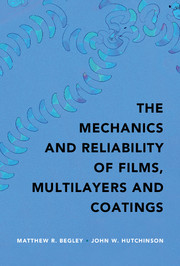Book contents
- Frontmatter
- Contents
- Acknowledgements
- Notation
- 1 Introduction
- 2 Key Mechanics Concepts
- 3 Linear Elastic Fracture Mechanics
- 4 Steady-State Delamination of Bilayers
- 5 Steady-State Delamination in Multilayers
- 6 Steady-State Channeling and Tunneling Cracks
- 7 Crack Kinking from an Interface
- 8 Crack Penetration, Deflection or Arrest?
- 9 Edge and Corner Interface Cracks
- 10 Buckling Delamination
- 11 Delamination of Thin Strips (Patterned Lines)
- 12 Delamination in Multilayers Subject to Steady-State Temperatures
- 13 Cracking under Transient Temperature Distributions
- 14 Software for Semi-Infinite Multilayers: Steady-State Delamination
- 15 Software for Semi-Infinite Multilayers: Transient Delamination
- 16 Finite Element Software for Multilayers: LayerSlayer FEA
- 17 Convergence and Benchmarks with LayerSlayer FEA
- Appendix Asymptotic Crack Tip Displacement Fields for an Interface Crack
- References
- Index
17 - Convergence and Benchmarks with LayerSlayer FEA
Published online by Cambridge University Press: 13 July 2017
- Frontmatter
- Contents
- Acknowledgements
- Notation
- 1 Introduction
- 2 Key Mechanics Concepts
- 3 Linear Elastic Fracture Mechanics
- 4 Steady-State Delamination of Bilayers
- 5 Steady-State Delamination in Multilayers
- 6 Steady-State Channeling and Tunneling Cracks
- 7 Crack Kinking from an Interface
- 8 Crack Penetration, Deflection or Arrest?
- 9 Edge and Corner Interface Cracks
- 10 Buckling Delamination
- 11 Delamination of Thin Strips (Patterned Lines)
- 12 Delamination in Multilayers Subject to Steady-State Temperatures
- 13 Cracking under Transient Temperature Distributions
- 14 Software for Semi-Infinite Multilayers: Steady-State Delamination
- 15 Software for Semi-Infinite Multilayers: Transient Delamination
- 16 Finite Element Software for Multilayers: LayerSlayer FEA
- 17 Convergence and Benchmarks with LayerSlayer FEA
- Appendix Asymptotic Crack Tip Displacement Fields for an Interface Crack
- References
- Index
Summary
As described in the previous chapter, the computation of energy release rates and stress intensity factors using the finite element method requires specification of various numerical parameters. These parameters relate to both the FE model itself (basically, the mesh) and the calculations performed during postprocessing of the FE results (basically, the calculation of the stiffness derivitive). In this chapter, the powerful automation of the LS-FEA framework is exploited to conduct extensive parametric studies, which illustrate the impact of these parameters on computational accuracy. The outcomes of these studies are used as the basis to establish recommended practices and default values for the associated numerical parameters, such as those in Table 16.1.
Convergence of Crack Tip Parameters
Numerical convergence in the present context is conceptually very simple; when the values of interest no longer change upon increases in mesh density (i.e., decreases in element size, often referred to as refinement), the model is said to have converged. In practice and especially for fracture problems, convergence can be more nuanced, as the behavior of different outputs will converge at different levels of mesh density. For example, when considering the potential energy of the system, and in many cases the energy release rate, convergence is achieved for much coarser meshes than when considering the crack tip stress intensity factors.
Such differences can create headaches if the spatial distribution of elements changes with refinement. For example, this would occur if the number of elements inside the focused fan region were increased, without changing the number of elements outside the focused region. Strictly speaking, mesh refinement to test convergence should involve a uniform increase in mesh density, such as would be achieved by splitting every element in themodel into four smaller elements. This can be prohibitively expensive, particularly for components that require dense meshes in multiple locations: for example, bending of a multilayer with one particularly thin layer.
In this chapter, we consider mesh refinements associated with increasing the number of elements around the crack tip in the focused region and in the fill regions. Practically speaking, the crack tip parameters become independent of the mesh upon increase of all or even some of these parameters.
- Type
- Chapter
- Information
- The Mechanics and Reliability of Films, Multilayers and Coatings , pp. 255 - 268Publisher: Cambridge University PressPrint publication year: 2017



